
Iron rich food is critical for our health but 33% of us are iron deficient. In menstruating women it’s way higher.
This is a big deal as iron deficiency symptoms include everything from extreme fatigue, inflammation and frequent infections to a racing heart, weird cravings and fainting.
Iron deficient kids fail to thrive.
But simple iron rich food tackles low iron symptoms fast and much more effectively than supplements.
So this is a huge guide to the best iron rich food covering :
- Iron rich meat like black pudding
- And iron rich seafood.
But also iron rich food for vegans and vegetarians including :
There are also low iron tips for :
PLUS key information on :
- Iron deficiency symptoms
- Iron deficiency & mental health
- Poor iron absorption
- And issues with iron supplements.
It has basically got all the info in one place I wish I had for the 30 years I suffered chronic iron deficiency despite taking iron supplements!!
Eating plenty of iron rich food truly has transformed my health. I hope this guide will help you and your family enjoy the benefits too.
This post is NOT qualified medical advice. Iron deficiency is a serious medical condition. See a doctor for persistent symptoms.
Table of Contents
Iron Deficiency

Simple iron deficiency explains lots of health – & mental health – issues.
But it is often ignored because we do not understand the basics of :
In this section I’ll explain these and common iron deficiency symptoms.
For the best iron rich food jump to the iron rich food section.
Iron Deficiency Symptoms

Iron is key to a huge range of body functions so iron deficiency shows itself in surprising symptoms.
Common low iron signs include :
- Poor circulation
- Fatigue & weakness
- Weak hair, skin & nails
- Inflammation & infection
- Weird food cravings
Poor Circulation
- Drained grey pallor
- Cold hands & feet
- Feeling the cold
- Restless legs
- Racing heart rate
- Short of breath
Fatigue & Weakness
- Extreme fatigue
- Narcolepsy
- Dizzy headaches
- Light headedness
- Fainting
Hair, Skin & Nails
- Frizzy hair
- Brittle nails
- Hair loss
- Bruising
- Cold sores
- Itchy scalp
- Deep rooted blackheads
Inflammation & Infection
- Frequent infections
- Slow healing
- General inflammation
- Inflamed tongue
- Sore mouth & infections
Weird Food Cravings
- Ice
- Clay
- Dirt
- Chalk
- Paper
Iron Deficiency Signs In Kids
Signs of low iron in kids include :
- Lost or small appetite
- Slow growth
- Slow development
- General failure to thrive
- Behavioural issues
- Lethargy & sleepiness
Low iron symptoms overlap with low magnesium symptoms so do also keep an eye on magnesium levels.
Can Low Iron Affect Your Mental Health?

Low iron can impact our mental health and contribute to :
Women are at raised risk of low iron, mental health issues in adolescence, post-pregnancy and menopause.
Teenage Girls
An estimated 40% of teenage girls have low iron levels which can explain sudden changes in mental health and school performance.
Low iron is a risk factor for & symptom of eating disorders and can lock teens into body dysphoria.
Post Natal Depression
Low iron levels are also a big risk factor for post natal depression. New mothers who do not often eat red meat should test for iron deficiency.
Perimenopause & Menopause
Mental health issues in menopause & perimenopause – e.g. brain fog, acute anxiety, anger – may be signs of low iron not hormone imbalance.
Poor Absorption Of Iron
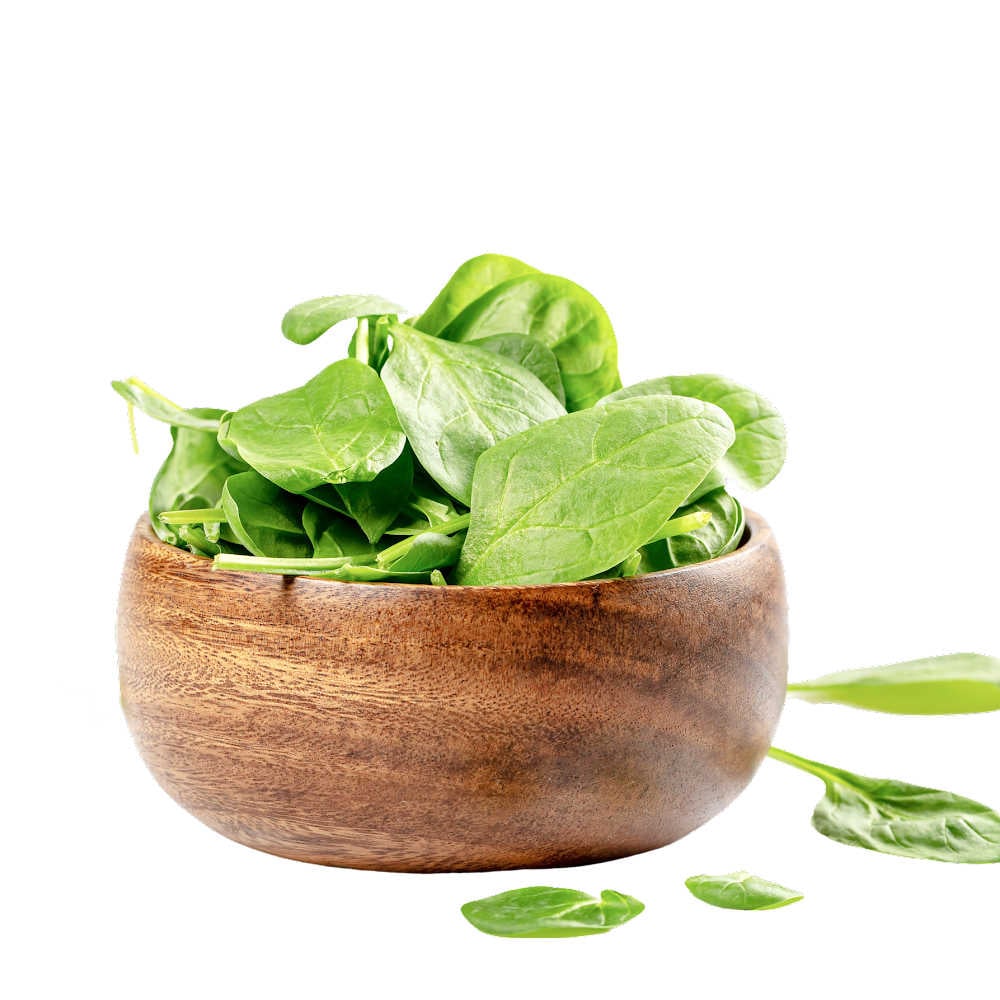
Not eating enough iron rich food is a major cause of iron deficiency.
But there is another problem.
We absorb at most 30% of iron listed on food packaging and can absorb less than 10% of iron listed. So we can be iron deficient because we don’t absorb the iron we do eat.
Eating iron rich food with vitamin A or C rich food can increase iron absorption by over 60% but other food blocks iron absorption.
What Foods Are Iron Blockers?
These foods block iron absorption :
- Coffee
- Tea
- Milk
- Other dairy
- Red wine
- Tannin rich food e.g. grapes, chocolate, unripe fruit, bananas.
Don’t take iron supplements within a few hours of eating any of these.
Antacids & Iron Deficiency
Antacids for acid reflux can block iron absorption and contribute to iron deficiency anaemia. Antacids should not be taken within 2 hours of iron rich food or supplements.
Two Different Types Of Iron
There are 2 types of iron in our food :
We absorb 3 times more heme than non-heme iron. So we get much less iron from a plant-food with the same listed level of iron content as a meat.
We actually absorb more iron from plants when we eat them with meat.
Daily Iron Requirements

Our daily iron requirements vary :
- At different times of our life
- Between sexes.
Daily recommendations vary by country but fall within these ranges :
Children
Kids from 7 months to 13 need 7-11 mg with more during growth spurts.
Teenagers
- Boys : 11mg
- Menstruating girls : 15 – 21.5 mg
Many menstruating teens do not eat enough iron rich food to meet this.
Men
- Adult men : 8-9 mg
Women
- Menstruating women : 15 – 19 mg
- Pregnant women : 27 mg
- Post menopausal women : 8-9 mg
If you have long, heavy or frequent periods – e.g. post-natally or in perimenopause – it is a good idea to test regularly for iron deficiency and boost iron rich food as necessary.
Do Iron Supplements Work?

Prescribed iron supplements can quickly raise iron levels for anaemia.
But OTC iron tablets don’t always work. I was repeatedly deficient or anaemic whilst taking them and benefited more from iron rich food.
If you struggle to eat iron-rich food, e.g. as a vegan, use these tips to boost iron tablet absorption :
- Take separate iron tablets not a multi-vitamin or mineral.
- Drink vitamin C rich fruit juice with your iron supplement.
- Take tablet on an empty stomach unless upsets your stomach.
- Don’t take within 2 hours of :
- Coffee
- Tea
- Milk or other dairy
- Antacids for heartburn
- A calcium supplement.
Don’t assume your iron supplements will work. Test iron levels annually if you are in a high risk group :
- Vegan
- Vegetarian
- Teenage girl
- Long, heavy or frequent periods.
Test straight away if you have any iron deficiency symptoms including new mental health issues.
Side Effects Of Iron Supplements
There are a number of possible side effects from regularly taking iron supplements :
- Constipation
- Bloating
- Heartburn
- Gastritis
- Nausea & vomiting.
They are less likely in a balanced diet containing a range of iron rich food.
OK, now we’ve looked at iron deficiency, let’s discover the iron rich food that quickly boosts iron levels.
Food Highest In Iron

The most iron rich foods are organ meat and blood sausages like black pudding but we can absorb iron from a wide range of other food.
So in this section I’ll take you through the most iron rich food in each of the following categories :
- Meat
- Seafood
- Vegetables
- Beans & Pulses
- Nuts & Seeds
- Dried Fruit
- Spices & Herbs
- Other Iron Rich Food.
I’ll flag key absorption issues in each category of food for you and then in the next section show you how to include foods in an iron rich diet :
- At different times of life e.g. menstrual cycle, perimenopause
- And on a meat free diet.
The Most Iron Rich Meat

Iron rich meat is very valuable for children, menstruating girls and women and people convalescing.
The most iron rich meat and meat products are mostly red meat :
- Spleen
- Black pudding or blood sausage
- Heart
- Liver
- Liverwurst
- Liver pate including chicken liver
- Kidneys
- Faggots – if butcher made
- Goose
- Giblets
- Beef of all sorts – good quality lean ground or minced beef is just about as iron rich as a steak
- Venison.
Many of these fell out of fashion but can be cheaper than white meat.
Typically, beef has 3 times more iron than chicken and the iron rich meats above can have 6 times as much.
This means we can eat less red meat without risking iron deficiency and actually save money whilst we are it.
Eating iron rich red meat can even help the environment because it is so nutritionally dense.
Iron Rich Organ Meat Recipes
If you’ve never cooked any before try these organ meat recipes for ideas :
If you are not ready for organ meat do try super iron rich black pudding.
Iron Rich Black Pudding

Black pudding – also known as a blood sausage – is very high in iron.
One helping of black pudding has 3-4 times more iron than steak. It is cheap, quick & easy to cook and easy to eat for kids and convalescents.
You can simply grill, bake or fry black pudding in slices or add it to all sorts of simple high iron recipes :
- With poached eggs
- With avocado on toast
- Black pudding frittata
- Black pudding benedict
- As meatballs
- Black pudding sausage rolls
- Black pudding colcannon
- With scallops in a salad
Iron Rich Seafood

Some seafood – not all – can be a very valuable source of iron. The most iron rich seafoods are :
Oysters and whelks are also rich in hormone balancing magnesium.
We are typically advised to eat 1-2 portions of oily & shell fish weekly but pregnant women shouldn’t eat raw shellfish & should limit oily fish.
Iron Rich Vegetables

Green leafy veg are the most iron rich vegetables and are essential for a healthy diet as they are so rich in minerals including magnesium.
The most iron rich vegetables are :
- Watercress
- Curly kale
- Collard greens
- Spinach
- Swiss chard
- Dandelion greens
- Broccoli
- Peas
- Jerusalem artichoke.
But we mustn’t delude ourselves about how much iron we can actually absorb from vegetables.
A 4oz bag of Popeye’s favourite spinach contains 36% of our daily iron requirement BUT remember we only absorb 10% of non-heme iron. So even if we eat the whole bag we only get 4-5% of our daily needs!!
So do eat greens daily but if you don’t eat red meat or seafood, you must eat a range of other iron rich food.
There are loads of yummy ideas here for eating 2 big helpings of green vegetables daily :
Iron Rich Beans & Pulses

Beans & pulses are valuable sources of iron in all diets as they are cheap and rich in fibre which boosts gut health and eases constipation.
Iron rich beans & pulses include :
- Black beans
- Lentils
- Black eye peas
- Chickpeas
- Kidney beans
- Butter or lima beans
- Pinto beans
- Soya beans
- Quinoa.
One helping of these beans can contain 40% of our daily iron needs but remember we don’t absorb most of the non-heme iron in plants so in reality 1 helping is closer to 10%.
Soaking dried beans and pulses overnight before cooking helps to increase iron absorption.
Check out these ideas for iron-rich bean and pulse recipes :
Iron Rich Nuts & Seeds
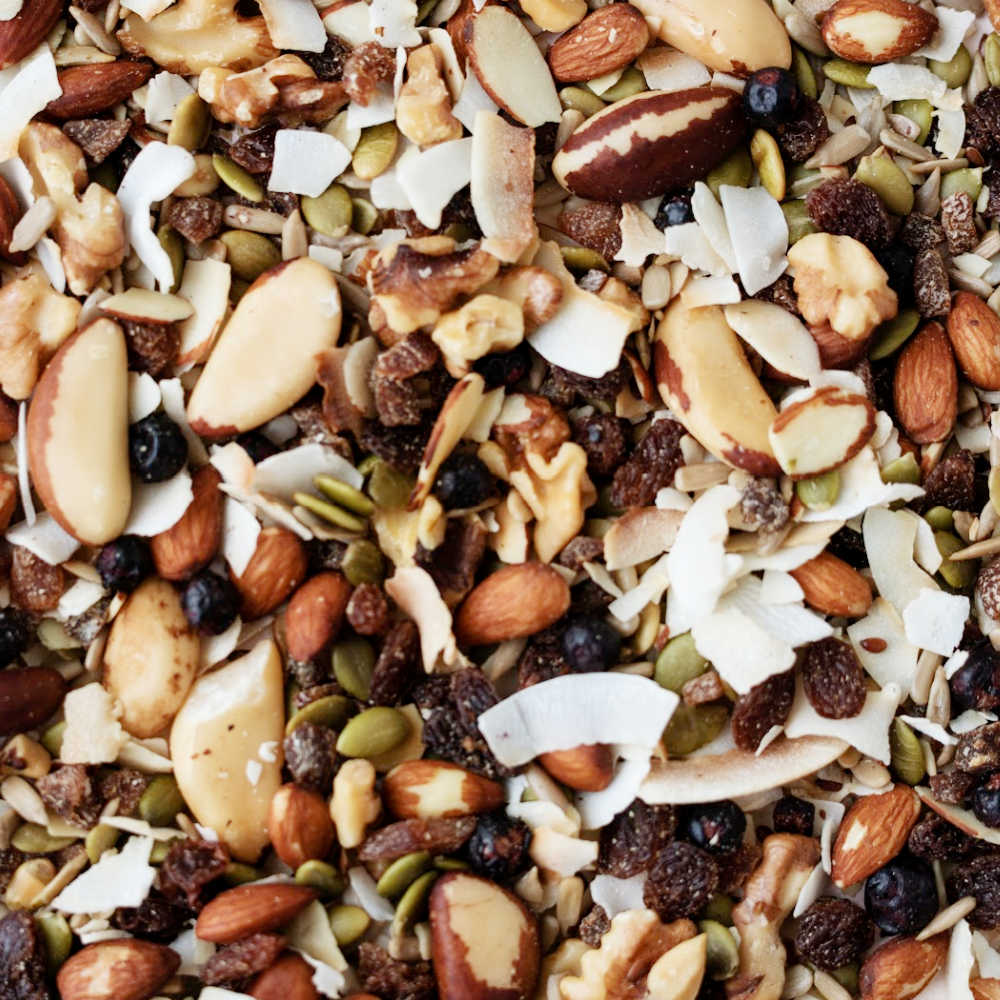
A wide range of nuts and seeds are rich in non-heme iron and other health benefits such as magnesium and essential fatty acids :
- Cashews
- Sunflower seeds
- Pumpkin seeds
- Hemp seeds
- Pistachios
- Hazelnuts
- Peanuts
- Pine nuts
- Linseed
- Hempseed
- Flaxseed
- Sesame seeds
- Chia seeds
We can easily add a variety of nuts and seeds to all sorts of meals to boost iron intake :
- Smoothies
- Quick cream soups
- Salads
- Stir fries
- Vegetable tray bakes
- Toppings for savoury bakes & cakes
- Oat bars, flapjacks & cookies
Nuts & seeds are calorific but their nutritional density – they are bursting with minerals!! – wards off hunger pangs so we eat less over all.
Iron Rich Dried Fruit

A range of dried fruit contain enough iron to be valuable for vegans & vegetarians. They are also a handy way for the whole family including kids to enjoy iron rich snacks.
The most iron rich dried fruit are :
- Apricots
- Figs
- Raisins
- Prunes
- Dates
- Goji berries
You may have read that there is iron in all sorts of fruit from bananas to water melon but it’s barely half a milligram of non-meme iron!!
Even if we absorb 20% – top of non-heme absorption range – we’ll only get 0.1 mg of iron. That’s barely 1% of a man’s daily iron needs and less than 0.3% of a pregnant woman’s.
The bottom line is fresh fruit does not have enough iron in it to help. We should eat it for other benefits including helping iron absorption.
Iron Rich Spices & Herbs

Surprisingly, some spices & herbs are iron rich and a few teaspoons per meal can meet 5% of daily needs.
That may not sound much but helps vegans & vegetarians in a meal plan that hits all iron rich food groups.
Try adding a good range of these spices and herbs into your diet :
- Thyme
- Basil
- Marjoram
- Spearmint
- Chilli pepper
- Parsley
- Fennel
- Cumin
- Curry powder
- Turmeric
- Celery seed
- Coriander
- Nettle
- Alfalfa
- Yellow dock
A number are natural antibiotics that help see off bacteria behind gastritis and cystitis so we can really benefit from building them into our diet.
As ever moderation is key.
We can consume too much and can’t chuck huge amounts into food to up iron without nasty side effects.
More Iron Rich Food

A number of other iron rich foods are useful for topping up iron levels.
Some are obvious like eggs but odd ingredients like molasses and cacao can also up kids’ iron levels :
- Eggs
- Molasses
- Tofu
- Tempeh
- Natto
- Cacao powder
- Morel mushrooms.
OK we now have a big range of iron rich foods to boost iron levels fast PLUS recipe ideas for enjoying them so let’s look next at how to build them into different iron rich diets.
Iron Rich Diets

Planning an iron rich diet is critical for certain lifestyles and life stages. It is especially so for women & girls.
I learned this the hard way with chronic iron deficiency for many years as a non-meat eater.
Don’t be me. Don’t wing it.
Use this section to plan out how you will get enough iron rich food in your diet when most vulnerable :
- Iron rich diet for your period
- Iron rich diet for vegans
- Iron rich diet for vegetarians
- Iron rich diet for kids
- Iron rich diet for convalescence
- Iron rich food for anaemia
- Managing iron deficiency in perimenopause & menopause.
Iron Rich Diet For Vegans
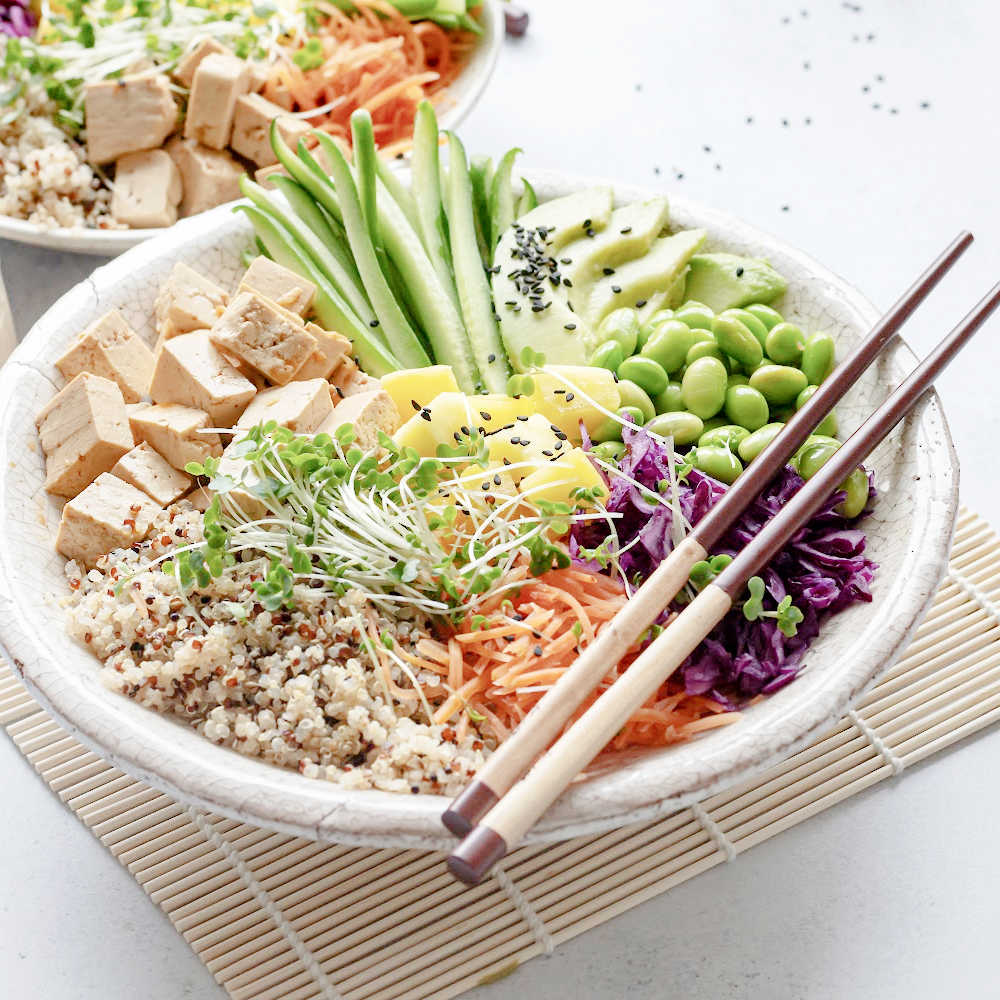
The challenge of an iron rich diet for vegans is non-heme iron. We only absorb 2-20% so no single food gives the same hit as iron rich meat.
Too many articles on vegan diets don’t mention absorption and make it look easy for vegans to get enough iron when for many women it is not.
So vegans must eat a range of food from all these high iron food groups :
- Iron rich vegetables
- Iron rich beans & pulses
- Iron rich nuts & seeds
- Iron rich dried fruit
- Iron rich spices & herbs
Vegans also need to focus on :
- Increasing iron absorption
- Brutal honesty about iron levels!!
How To Improve Iron Absorption On A Vegan Diet
Five key tips for boosting iron absorption on a vegan diet are :
- Avoid coffee / tea with meals
- Eat vitamin C in each meal
- Cook in cast iron pans
- Include iron in all meal & snacks
- Meal plan carefully.
Meal planning is critical as it is unbelievably easy to kid ourselves we get enough iron because we are so committed to being vegan!!!
Brutal honesty is essential.
Be Honest About Iron Levels
If you are turning vegan I would :
- Test iron levels before starting
- Again after a few months
- Then annually
- Or if you experience unexplained symptoms of iron deficiency.
Don’t swallow the myth an iron supplement will work on its own.
Do listen to your body.
For many of us being vegan or vegetarian is a religion we cling to with unquestioning faith the more people challenge us. That faith can blind us to even the most obvious symptoms of iron deficiency.
I ignored my symptoms for decades because I did not want to admit my meat free diet was making me ill.
I am not saying don’t be vegan but do hear your body when it is screaming loud and clear that it is sick!!
Iron Rich Diet For Vegetarians
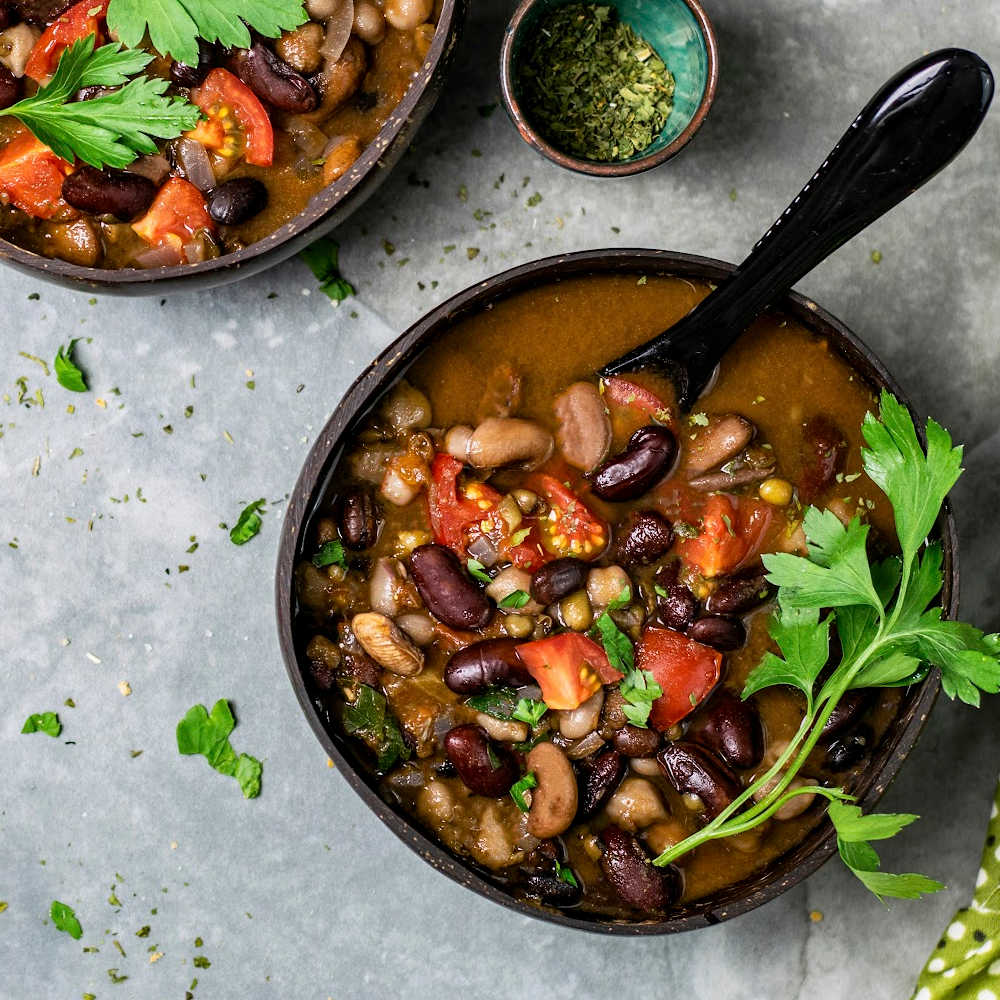
An iron rich diet for vegetarians can seem easier than a vegan diet because you can eat eggs.
A couple of eggs can meet 25% of a man’s daily iron needs but that is only 10% of a teenage girls.
Vegetarians have another iron problem. Many over rely on dairy for protein but calcium cuts absorption of both heme & non-heme iron.
So vegetarians need – like vegans – to eat from each of these iron rich food groups every day :
- Iron rich vegetables
- Iron rich beans, pulses & grains
- Iron rich nuts & seeds
- Iron rich dried fruit
- Iron rich spices & herbs
And need to avoid slathering all our iron rich food in cheese sauce!
Iron Rich Diet For Your Period

Many teenage girls & women suffer extreme fatigue during periods.
We are not talking being a bit tired but being utterly wiped out and struggling to get out of bed.
The main cause is iron deficiency.
Other symptoms of iron deficiency during periods can include :
- Light headedness
- Out of control tears at tiny things
- Anxiety attacks
- Very drained pallor
- Restless legs
- Weird food cravings
- The shakes
- Fainting
- Desire to binge on food – low iron has a complex vicious-circle connection with body dysphoria.
So plan to increase iron intake the week before and during your period :
- Eat the most iron rich meat you can, e.g. black pudding, liver, venison, steak not chicken!!
- If pescatarian eat iron rich seafood like mussels, sardines or scallops.
- Make trail mix of iron rich nuts, seeds & dried fruit to snack on, and carry some round with you.
- Make your own iron rich dips by blending iron rich beans & pulses with iron rich herbs & spices plus olive oil & lemon juice.
- Increase your intake of iron rich vegetables with green soup and green juices or a green smoothie.
These last two will also relieve constipation a period pain trigger.
Perimenopause & Iron Deficiency

Many women don’t realise that perimenopause starts in our late 30s with heavier, more frequent periods.
Or know that iron deficiency is common, as a result, in women in their forties, especially late mothers.
Women hitting 40 should check iron levels especially with these signs :
- Extreme fatigue
- Chronic anxiety
- “Brain fog”
- Out of control emotions
- Inability to exercise without breathlessness
- Poor immunity & big infections
We talk much more about perimenopause & menopause symptoms these days but then too often dive down the rabbit hole of pricey hormone solutions.
Very often it is just iron deficiency!!
And we can restore iron levels with an iron rich diet for perimenopause.
For some women that means eating red meat again, which is a tough call as a long term vegetarian or vegan but it can transform our health.
As I hit 40 with a baby I suffered :
- Endless feverish infections
- Constantly swollen glands
- Shingles
- And overwhelming anxiety.
A long term vegetarian friend ended up in hospital with pneumonia. She was told it was not at all uncommon.
The primary cause was chronic iron deficiency in perimenopause.
Tackling my iron deficiency by eating meat again transformed my health.
An Iron Rich Diet For Perimenopause
The iron rich diet for perimenopause that has worked for me includes :
- Iron rich meat e.g. black pudding, lean beef, liver several times a week
- Iron rich seafood two times a week
- Lots of iron rich leafy greens every day in e.g. quick green soup
- Plenty of eggs
- A good sized handful of iron rich nuts & seeds daily
- Flavouring meals with iron rich spices & herbs rather than salt
- A good helping of iron rich beans & pulses on meat & fish free days.
Black pudding is fantastic iron medicine during perimenopause because it has high levels of easily absorbed iron. A doctor prescribed it for my pneumonia struck friend.
If you haven’t tried it discover how to eat black pudding as iron medicine.
For more help flourishing in perimenopause read these posts :
Iron Rich Food For Kids

Iron rich food for kids is super important especially when they are going through a growth spurt.
The challenge of course is kids can be horribly picky eaters, so we may need to smuggle iron rich food in.
Use these tricks to sneak loads more iron rich food into your kids :
- Liver Stew : slow cook with liver cut so small it’s soft to chew.
- Black Pudding : serve with an egg on top for iron medicine that is super easy to digest.
- Good Quality Ground Meat : beef or lamb mince can be as iron rich as joint meat but kids will eat more.
- Blend In Green Vegetables : smuggle iron rich but not bitter spinach, collard greens & leafy brussel tops into :
- any sauce they will eat
- cream soups
- smoothies – spinach is good in this berry smoothie.
- Add Beans To Soups : blend beans – white beans work best – into their fave tomato, mushroom or chicken cream soups.
- Dried Fruit Snacks : iron rich dried fruit like apricots are great snacks for kids.
- Add Nuts To Everything : if your kids don’t have allergies, fine grind iron rich nuts & seeds into everything :
- smoothies
- sauces
- soups
- savoury bake toppings
- muffins, cakes & cookies as long as not going to school.
- Homemade energy bars : find an easy iron rich oat bar or energy bar recipe they love. The one below is super rich in iron rich nuts & seeds. If your kids don’t do “bits” finely grind up the nuts and seeds before adding to your recipe …
Iron Rich Diet For Convalescence

Iron rich food is critical when we are convalescing. We need iron to :
- Keep fighting infection
- Repair & grow new cells.
But loss of appetite means we need easily digestable iron rich food.
These traditional convalescent foods can help build up iron supplies :
- Liver pates
- Bone broth
- Beef tea
- Bone broth jelly
- Oxtail soup
- Eggs
- Black pudding
For more tips on what to eat when convalescing read this post on how to get energy back after sickness.
Iron Rich Food For Anaemia

Qualified medical support and iron supplements are essential when our iron levels fall so low we have iron deficiency anaemia (IDA).
But we can boost iron levels fast with the most easily absorbed iron rich food. This basically means red organ meat or as also known offal :
- Liver
- Kidneys
- Heart
- Spleen
- Stomach
- Tripe
- Sweetbreads
- Black pudding.
We have forgotten how to cook most of these but there are lots of simple ideas in these:
And there you go. A huge guide to iron rich food to help you :
- Recognise iron deficiency
- Identify all sorts of iron rich food
- And build it into an iron rich diet.
I hope it helps boost your iron levels.
If you found it helpful please do bookmark and share. And I would love to hear about your feedback.
For more simple practical health tips do check out these guides :

Photos: Various seeds , nuts seeds , pumpkin seeds, Spinach leaves in a wooden bowl, Glass bowl with cottage cheese, nuts and flax seeds , Dried apricots, raisins and dates in white masks on a black background by Marco Verch under Creative Commons 2.0








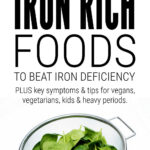














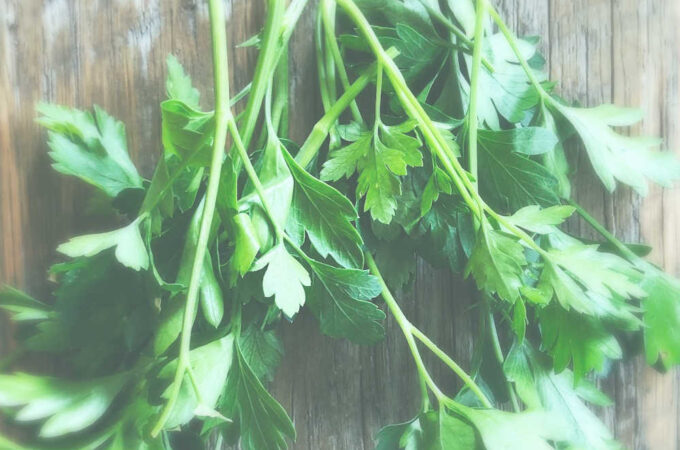
Leave a Reply